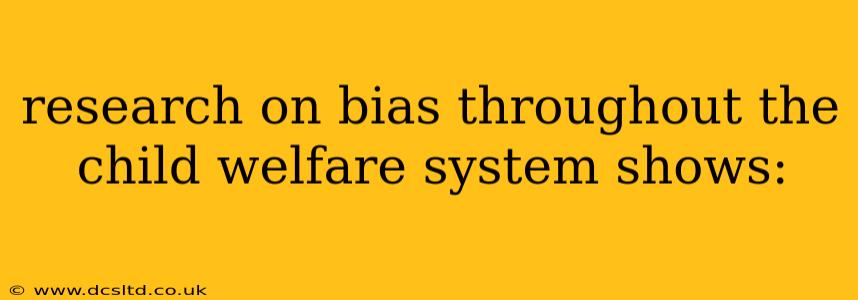Research on Bias Throughout the Child Welfare System Shows… Systemic Inequities and Urgent Need for Reform
Research consistently reveals significant bias permeating the child welfare system, leading to disproportionate involvement and negative outcomes for children and families from marginalized communities. This isn't simply a matter of isolated incidents; it's a deeply entrenched problem stemming from systemic issues rooted in racism, poverty, and implicit bias. Understanding the nature and extent of this bias is crucial for advocating for meaningful reform and creating a more equitable system.
What are the key biases identified in child welfare research?
Research highlights several key areas where bias manifests within the child welfare system:
-
Racial Bias: This is arguably the most pervasive form of bias. Studies repeatedly demonstrate that children of color, particularly Black and Indigenous children, are disproportionately reported to child protective services, investigated, and placed in out-of-home care compared to their white counterparts, even when controlling for socioeconomic factors. This disparity isn't solely due to higher rates of maltreatment; it reflects biased reporting, investigation practices, and decision-making within the system.
-
Socioeconomic Bias: Poverty is another significant factor contributing to disproportionate involvement in the child welfare system. Families struggling with financial hardship often face increased scrutiny, even when the challenges they experience are not directly related to child maltreatment. Lack of access to resources, such as stable housing, adequate healthcare, and quality childcare, can lead to reports that might not be substantiated in more affluent communities.
-
Implicit Bias: Unconscious biases held by child welfare professionals can significantly impact assessments, investigations, and case decisions. Implicit biases, which are ingrained attitudes and stereotypes that operate outside conscious awareness, can lead to unfair judgments and discriminatory practices, even when professionals are unaware of their own biases.
-
Bias Against LGBTQ+ Families: LGBTQ+ families, particularly those headed by same-sex couples or transgender parents, face unique challenges within the child welfare system. These families may experience increased scrutiny, unfounded concerns about their parenting abilities, and even discriminatory practices based on societal prejudice against their sexual orientations or gender identities.
How does this bias manifest throughout the child welfare process?
Bias doesn't occur in isolation; it impacts every stage of the child welfare process:
-
Reporting: Reports to child protective services are often influenced by biases held by reporters, including teachers, medical professionals, and neighbors. Certain behaviors might be interpreted as concerning in one community but overlooked in another, perpetuating disparities.
-
Investigation: Investigations can be biased, focusing more intensely on families from marginalized communities. This can lead to more substantiated cases and out-of-home placements, even when the level of risk is comparable to cases in other communities.
-
Case Planning and Decision-Making: Decisions regarding family reunification, foster care placement, and adoption are also susceptible to bias. Caseworkers, judges, and other professionals may unintentionally make decisions that disproportionately impact marginalized families.
What are the long-term consequences of this bias?
The consequences of bias within the child welfare system are far-reaching and devastating:
-
Trauma and Instability: Children who experience removal from their families face significant trauma, and the instability of the child welfare system exacerbates their challenges.
-
Educational Disparities: Children in out-of-home care often experience disruptions to their education, leading to lower academic achievement and reduced opportunities.
-
Mental Health Issues: Exposure to trauma and instability can lead to higher rates of mental health challenges among children involved with the child welfare system.
-
Racial Disparities: These disparities perpetuate systemic racism and inequity, impacting the life chances and overall well-being of children and families from marginalized communities.
What can be done to address bias in the child welfare system?
Addressing bias requires a multi-pronged approach:
-
Increased Cultural Competency Training: Child welfare professionals need comprehensive training to recognize and mitigate their own biases, understand the impact of systemic racism and inequality, and develop culturally competent practices.
-
Data Collection and Analysis: Rigorous data collection and analysis are crucial to identify and track disparities, allowing for targeted interventions.
-
Community-Based Services: Investing in community-based services, such as family support programs and mental health services, can address the root causes of child maltreatment and reduce the need for child welfare involvement.
-
Policy Reform: Policy changes are needed to ensure equity and fairness within the child welfare system, including modifications to reporting, investigation, and case planning processes.
This is a complex issue requiring ongoing research, dialogue, and systemic change. Addressing the bias within the child welfare system is essential for protecting children and promoting equity for all families.
